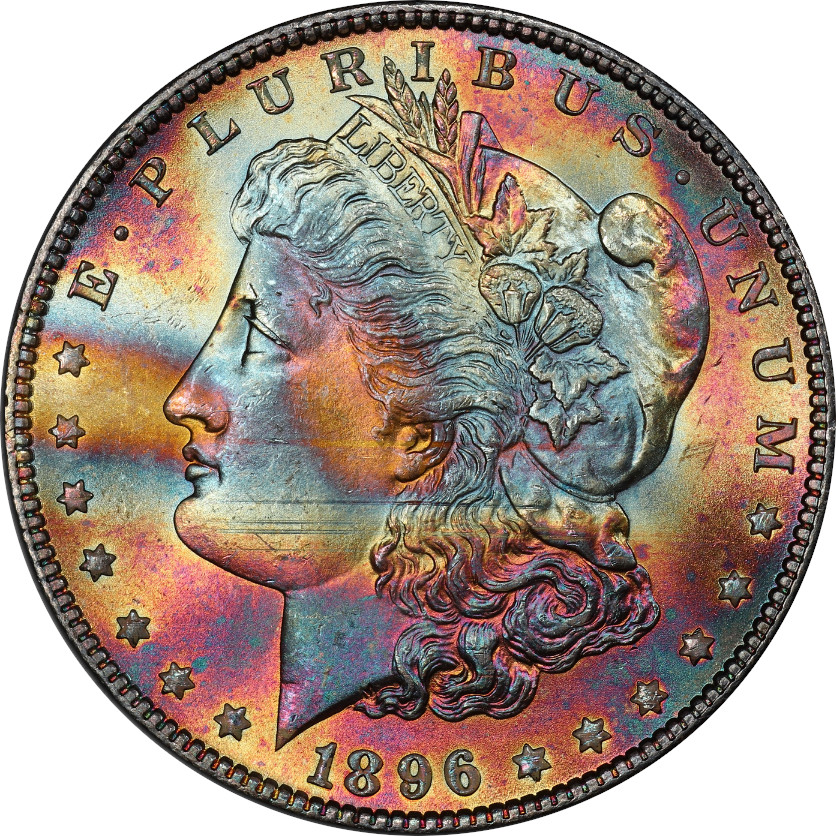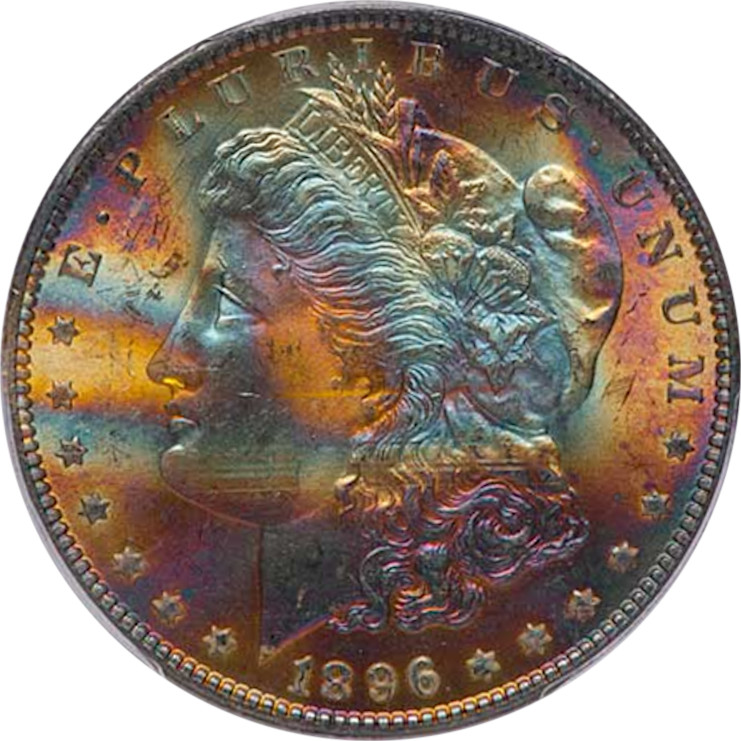This week, we’ve picked an interesting one.

1896 Morgan Silver Dollar PCGS MS65 Obverse, Photo by Phil Arnold
This 1896 (common date) Morgan Silver Dollar is graded PCGS MS65, Green CAC. The recent PCGS holder has it pedigreed to the Aurora Borealis collection.
PCGS Price Guide for an 1896 Morgan Silver Dollar in Mint State 65 is $150. Hundreds of 1896 Morgans have sold this year for $100 to $200. So why did this coin sell for $4,465?
Well, the answer is obvious – it’s all about the toning. The pedigree doesn’t hurt either! But how did the buyer come up with that price? Is it just a magic number that popped into his or her head when they saw the coin?
Let’s dissect it a bit and see what we can come up with.
First of all, is the coin over or undergraded?
Nope. It’s right on. The reverse is marked up in the breast, otherwise the reverse could seven. By the way, the reverse has no toning. The obverse shows a pretty weak strike, normal for ’96-Ps. It even has massive striations, a planchet flaw, not from any kind of friction or bag. These striations didn’t play into the grade. The strike did. Ignoring the striations, as the graders did, and looking purely at the bag marks, the coin could ‘6+ or maybe even 7, except that a couple of the marks are unmissable. But the strike takes off a point, and the striations keep it out of a plus as the coin is not exceptional for the grade.
The toning and luster, however, are.
One of us here, in particular, likes to look at the toning just like the rest of us look at problems on coins. “How much does the toning of the coin improve or decrease the grade of the coin?” “What grade of naturally untoned coin would I prefer to have?” You can do this with problem coins, too – how much does that environmental damage impact the coin. If you can quantify it into a grade number, you may help yourself arrive at numbers when ready to buy and sell pieces from your collection.
Of course, these numbers are all completely personal. Everyone will have a different opinion. But at least, it could be a starting point.
Looking at Phil’s photographs of the coin, I’d say I’d rather have this coin than your run-of-the-mill 6, maybe even 6+. This isn’t my favorite toning. If there was a coin like this, a 5, with perfect (in my opinion), double-sided, natural toning, I might rather have it than an 8. But not this one, not for me. Not looking at these pictures.
But let’s look at Patrick’s shot of the coin. It shows the luster much better. (I’m not trying to compare Patrick and Phil’s photography – they do different things, and that’s how it should be. In this case, Phil’s photo shows more detail, and Patrick’s shows a bit better what the coin looks like in-hand.) This coin has incredible, luminous luster. Looking at the Legend photo, I’d rather have this coin than a 7. I’m not huge on the striations, and I don’t have to have this kind of toning in my collection, and it’s not double-sided. But for me, at least, it takes it into 6+ or possibly 7 territory.

1896 Morgan Silver Dollar PCGS MS65 CAC Obverse, Photo by Patrick Braswell
For the auction winner and underbidder, this coin was apparently a 7+. (If they applied this kind of logic to their preparatory thinking. Of course, it could just be a “had to have it, money is no object” moment, too.) Looking at some of the recent auction results for ‘7 and 67+ coins, we see they range from a couple grand up to almost 8 territory. And seeing as there hasn’t been an 8 to come to auction for a while, and this wild toning, it certainly was the coin a couple of people had to have.
